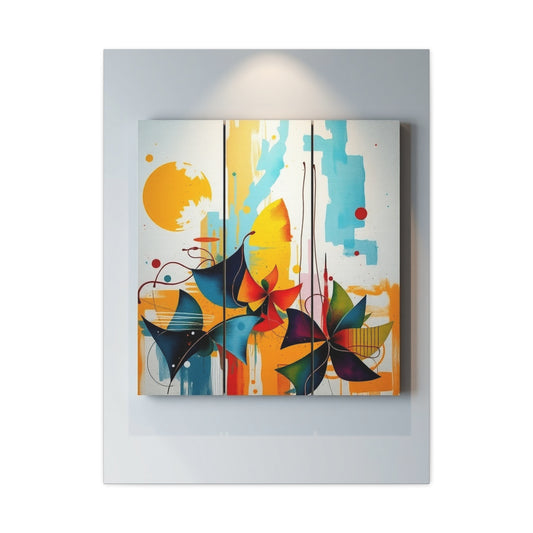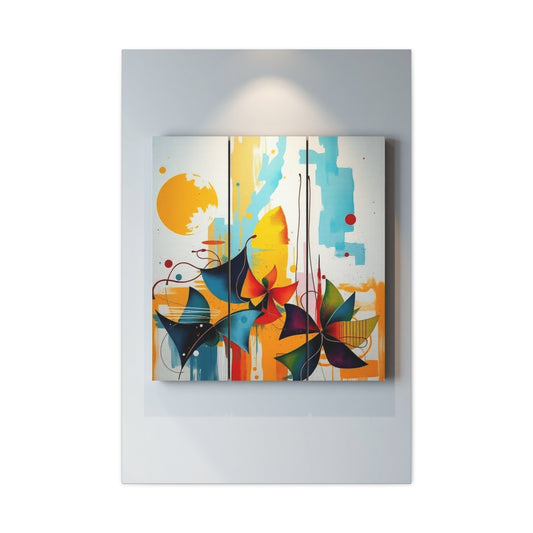There is something endlessly captivating about pairing words with visual design. The human mind naturally latches onto language, while the eye is drawn to form, shape, and contrast. When those two forces meet, the result can be a striking piece of décor that is both meaningful and aesthetically pleasing. One of the latest ways this creative pairing is being explored in home interiors is through what is often referred to as definition wall art. These works of art rely on typography as the primary focus, often presenting a carefully chosen word or phrase paired with a sleek, minimalist layout. They blur the line between literature and design, reminding us that words can be as powerful to look at as they are to read.
The essence of the definition of wall art lies in its simplicity. At first glance, these pieces may look modest compared to ornate paintings or elaborate illustrations. Yet their power rests in restraint. The clean fonts and thoughtful spacing force the viewer to pause and absorb the meaning rather than being distracted by unnecessary clutter. Just as a poet chooses words sparingly to deliver maximum impact, definition prints reduce visual noise to let meaning take center stage. This is precisely why they have grown so popular in recent years. People crave balance in their spaces, and these artworks deliver a dose of calmness while still engaging the mind.
Minimalist art has long been admired for its ability to enhance interiors without overpowering them, and typography-based wall prints are a natural continuation of this idea. Where once people hung decorative calligraphy or framed quotes, definition prints now offer a more modern approach. They borrow from dictionary-style layouts, showing a word in bold type followed by a short explanation of its meaning. This academic structure gives them a timeless, intellectual quality. It feels both sophisticated and approachable at the same time.
An advantage of these artworks is their versatility. Because they focus on a single word or phrase, they can be adapted to nearly any interior style. In a romantic bedroom, a definition of “love” presented in soft tones against a neutral background can become a focal point, anchoring the atmosphere with a gentle message. In a workspace, words like “focus” or “creativity” framed neatly on the wall can serve as constant reminders of motivation and purpose. Living rooms, kitchens, and even entryways can benefit from the subtle personality these works introduce. They communicate values without demanding attention in a loud or intrusive way.
Another reason definition wall art has risen in popularity is its alignment with current design trends that prioritize intentionality. Modern interiors often emphasize sustainability, mindfulness, and meaningful décor choices. Rather than filling a room with generic decorations, homeowners are increasingly drawn to pieces that reflect their personal identity or beliefs. A carefully chosen word hanging on the wall is more than just decoration; it becomes a statement of what the household stands for. A guest who walks into a living room and sees a framed definition of “kindness” will instantly understand something about the values of the people who live there.
This type of décor also plays well with color psychology, even when the prints themselves are in simple black and white. A surrounding color scheme can influence the way the word is perceived. For example, pairing a definition of “serenity” with pale blues and soft greys enhances the calming atmosphere, while setting a definition of “energy” against vibrant yellows or oranges reinforces the message. In this way, definition art can be a flexible anchor for larger design choices. The typography remains neutral, but the meaning it conveys shifts depending on the surrounding palette and textures.
Romantic spaces often benefit from the addition of words tied to emotion. A bedroom designed with comfort in mind may use plush fabrics, warm lighting, and subtle floral accents. Hanging a definition of “romance” or “affection” within this environment adds depth to the theme. It quietly unifies the decorative choices, reminding the inhabitants of the feelings the room is meant to foster. Unlike overtly sentimental art, which can sometimes feel saccharine, minimalist definitions strike a balance by keeping emotion present yet understated.
Beyond personal relationships, definition wall art can also reflect cultural trends. Contemporary design often celebrates hybridity, combining elements from multiple traditions to create something fresh. For example, a living space influenced by Japandi style—a blend of Japanese natural philosophy and Scandinavian minimalism—may use muted earth tones, clean lines, and functional décor. Within that environment, a framed definition of “harmony” or “balance” feels perfectly aligned. The art not only complements the design visually but also reinforces the underlying philosophy of the space.
Plants have become another central component of modern interiors, thanks to the growing awareness of biophilic design. The idea is that connecting with nature indoors can reduce stress and boost wellbeing. When lush greenery fills a corner or shelf, definition prints can provide a textual counterpart. A word like “growth” placed above a collection of houseplants highlights the symbolic connection between the natural world and personal development. The print becomes more than décor—it interacts with the living elements around it to tell a story.
Colorful approaches to definition art are also gaining ground. While many designs stick to monochrome palettes, some experiment with bold backgrounds or accent hues. These are particularly effective in spaces where homeowners want to express personality or highlight a feature wall. Imagine a definition of “joy” printed on a sunny yellow canvas, or the word “creativity” rendered against a teal backdrop. These variations demonstrate that typography art is not confined to strict minimalism; it can be playful and daring while retaining its intellectual edge.
The resurgence of vibrant shades in interior design has further boosted this trend. Bright tones like fuchsia, mustard, or cobalt blue are being used to inject personality into neutral-heavy spaces. Definition prints with pops of these colors act as bridges between the bold and the subdued. They bring energy without overwhelming the overall aesthetic, making them perfect tools for balancing adventurous choices with more restrained décor.
Another stylistic innovation is the use of split-canvas layouts. Rather than confining a word and its definition to a single frame, designers have begun experimenting with dividing the content across two or more panels. One panel might display the word itself in large font, while the accompanying panel presents the definition in smaller text. This break from convention adds visual intrigue and creates a sense of movement across the wall. It also allows larger spaces to be filled without resorting to oversized, heavy artworks. Split-canvas typography introduces balance and rhythm, qualities often sought after in contemporary interior design.
More than just style, these artworks can carry messages of substance. In an age where personal values and social awareness play a large role in how people decorate their homes, definition prints offer a platform for quiet activism. Words like “equality,” “respect,” or “justice” framed on the wall deliver powerful reminders without resorting to aggressive slogans. They allow individuals to merge their commitment to important causes with their passion for thoughtful design. Visitors notice the statement, reflect on its meaning, and engage in conversation, all while appreciating the minimalist artistry.
The adaptability of definition wall art makes it particularly appealing for those who frequently change or update their spaces. Unlike heavily themed décor items, a simple typographic print can remain relevant through multiple interior makeovers. It is neutral enough to adapt, yet meaningful enough to retain its significance. This longevity aligns with the desire for sustainable design practices, encouraging people to invest in pieces that won’t feel outdated in a year or two.
Typography has always played an important role in design, whether in books, posters, or architectural inscriptions. Over time, the way words appear in physical spaces has shifted, adapting to new cultural and artistic movements. Today, definition wall art represents one of the most refined expressions of this tradition, combining typography with interior decoration in a way that is both contemporary and timeless.
To understand why this form of décor resonates so strongly, it helps to place it within a broader historical context. Words have long been used decoratively in human environments. Ancient inscriptions on temples, medieval illuminated manuscripts, and Renaissance engravings all show how written language can become art in its own right. The modern rise of typography-based wall décor continues this legacy, but with an emphasis on minimalism, personal meaning, and everyday accessibility.
What makes definition wall art particularly distinct is its focus on precision. Rather than lengthy passages or elaborate quotations, these works use a single word and its definition. The conciseness strips language down to its essence, mirroring the minimalist philosophy that values clarity over excess. This approach resonates with today’s preference for clean lines, functional spaces, and intentional choices. In an age of information overload, the simplicity of one word framed on a wall can feel refreshing and grounding.
Typography itself carries personality, and the choice of font can drastically change the feel of a piece. A serif font, with its traditional embellishments, may evoke a sense of history and authority, making the definition appear scholarly or classic. A sans-serif font, on the other hand, projects modernity and sleekness, aligning well with contemporary interiors. Even within minimalist design, subtle variations in typeface, spacing, and alignment can shift the emotional tone. This flexibility is one of the strengths of definition wall art—it can be tailored to feel romantic, professional, playful, or contemplative, all depending on how the letters are presented.
Interior designers often use typographic art as a balancing tool. Spaces filled with textures, patterns, and colors can benefit from the visual pause that words provide. Unlike figurative or abstract paintings, which might compete for attention, typographic art has a calming uniformity. It commands interest without overwhelming. The viewer’s eyes rest on the word, linger on its meaning, and then return to the broader room with renewed appreciation. In this sense, definition prints act like punctuation marks in interior design—they provide rhythm and structure to the visual narrative of a space.
Another reason for their popularity lies in the human connection to words. Unlike purely decorative art, which may be admired for beauty alone, words invite intellectual and emotional engagement. Seeing the definition of “hope” or “wanderlust” on a wall sparks associations, memories, and feelings unique to each person. This makes definition wall art both universal and personal. The same piece can resonate differently with every viewer, depending on their life experiences and perspectives. That quality of open interpretation is part of its charm.
The adaptability of definition prints across different rooms also adds to their appeal. In a living room, a definition that celebrates community or joy can help anchor the social atmosphere. In a dining space, a word associated with nourishment or gratitude adds an extra layer of meaning to shared meals. Home offices may benefit from motivational terms tied to productivity, while entryways are ideal places for welcoming words that set the tone as people enter the home. Even bathrooms and hallways, often overlooked in decorating schemes, can be elevated with simple definitions that lend personality to smaller spaces.
|
Related Catagories: |
The rise of open-concept living areas has also contributed to the success of typographic décor. In large, multi-functional rooms, it can be difficult to create focal points without cluttering the space. Definition wall art offers a streamlined solution. A large canvas with a single word, hung strategically, can anchor the room and prevent it from feeling empty or unfinished. Its clean design works well with the airy, spacious feel of open layouts, while its message helps define the mood of the entire environment.
Color once again plays a significant role. While many definition prints are monochromatic, incorporating them into a room often involves thoughtful color pairing. Neutral backgrounds, such as whites, greys, and beiges, enhance the crispness of black typography, creating a timeless look. Alternatively, bold accent walls provide a striking contrast that can turn a simple definition into a dramatic centerpiece. For example, a dark navy wall can give a framed white print a gallery-like quality, while a bright coral wall might infuse the same piece with playful energy. The adaptability to different palettes makes typography art a reliable design tool across changing trends.
Textures also interact meaningfully with typographic décor. A framed definition hung above a rustic wooden console communicates something different than the same print displayed in a sleek, modern office. Materials such as metal, glass, or linen can alter the overall impact. Rough textures emphasize authenticity and warmth, while smooth surfaces highlight precision and clarity. Homeowners can play with these contrasts to reinforce their chosen aesthetic, all without changing the core simplicity of the artwork itself.
Cultural context further shapes how these artworks are perceived. A definition in one language may evoke entirely different associations when translated into another. Multilingual homes sometimes use definition prints to celebrate their cultural roots, choosing words in languages that carry personal significance. This not only personalizes the décor but also highlights the global versatility of typographic art. It demonstrates that words, though bound to language, carry universal power in design.
The psychological dimension of the definition of wall art should not be overlooked. Words have proven effects on mood and mindset. Reading affirming or thought-provoking terms daily can reinforce positive habits and emotional resilience. For example, a definition of “patience” displayed in a busy household may serve as a subtle reminder in moments of stress. Similarly, a definition of “courage” can inspire strength in personal or professional challenges. While these artworks may not replace deeper practices of mindfulness, they contribute quietly to the emotional landscape of a space.
In group settings, typographic prints can also spark conversation. Guests may ask about the choice of words, leading to discussions about personal meaning and values. Unlike abstract art, which often requires interpretation, definition prints provide a clear starting point. The shared understanding of language creates a bridge between viewer and host. In this way, definition wall art functions not just as decoration but as a social tool, facilitating connection and dialogue.
Another fascinating aspect of definition wall art is how it challenges the boundaries of traditional art forms. Historically, art was expected to be visual, while words belonged to literature. Typography-based décor erases this division, asserting that language itself can be a visual medium. The spacing, arrangement, and proportion of letters become as significant as the meaning they convey. This blurring of categories reflects broader cultural shifts that value hybridity, interdisciplinarity, and innovation.
From a practical perspective, the maintenance of these artworks is straightforward. Their minimalist design means they rarely require elaborate cleaning or restoration. Unlike fragile materials or complex installations, typographic prints are easy to preserve, making them a sustainable long-term choice. For people who frequently update their interiors, these pieces can be relocated, reframed, or re-contextualized with ease. Their simplicity ensures that they remain relevant even as other design elements evolve.
In communal environments such as cafés, studios, or co-working spaces, definition wall art offers a way to set tone and identity without overwhelming visitors. Words like “community,” “innovation,” or “comfort” displayed prominently can reinforce the mission of the space. They send subtle signals about the atmosphere while remaining adaptable to various design styles. Because of their neutrality, these artworks work equally well in public and private settings, highlighting their universal applicability.
The future of typographic décor promises continued innovation. Advances in printing, digital design, and customization allow for increasingly creative expressions. While traditional dictionary-style layouts remain popular, new interpretations experiment with layered textures, mixed media, and three-dimensional installations. Some designers integrate lighting or projection, allowing definitions to shift or glow dynamically. These experimental approaches expand the possibilities of what definition wall art can be, ensuring its relevance for years to come.
At its heart, however, the enduring appeal of definition wall art lies in its ability to marry clarity with depth. It distills vast ideas into a single word, presented elegantly enough to belong in any space. It invites viewers to pause, reflect, and find meaning in simplicity. In a world often dominated by noise and excess, these artworks remind us of the quiet power of words. They demonstrate that minimalism is not about emptiness but about intention, that restraint can produce resonance, and that even the most modest décor can carry profound significance.
When people think about decorating a home, their first instinct is often to focus on furniture, paint colors, or larger statement pieces like rugs and lighting. Yet the subtler details often carry equal weight in shaping how a room feels. Among these subtler elements, wall art has always held a powerful role. The right artwork can alter the entire mood of a space, turning a bare wall into a meaningful backdrop for daily life. Within this spectrum, definition wall art has carved out a unique position, precisely because of its ability to guide atmosphere through carefully chosen words.
Words are powerful mood-setters. A space defined by a print of the word “calm” feels different from one anchored by “ambition.” These differences may be subtle at first, but they accumulate in the way inhabitants and visitors experience the room. Unlike abstract or figurative art, which leaves interpretation wide open, typographic prints reduce ambiguity. The meaning is there in black and white—literally or figuratively—ready to inform the ambiance of the environment.
One of the most effective ways definition art influences atmosphere is through emotional cues. Humans are naturally wired to respond to language emotionally. Reading words tied to love, joy, or serenity can trigger corresponding associations in the mind. This makes typographic décor not just visual, but psychological. For example, in a bedroom designed for rest, a definition of “serenity” printed in soft tones can reinforce the intention of the space. In a bustling kitchen, the word “gather” might highlight the sense of community and togetherness that meals represent. These small reminders contribute to shaping daily rituals and emotional experiences.
Another factor that makes definition prints effective mood-setters is their versatility across styles. They can fit seamlessly into minimal interiors, where clean lines and muted tones dominate. At the same time, they can be adapted into eclectic or maximalist spaces as grounding elements. Imagine a room filled with patterned textiles, bold colors, and layered furniture: amid this visual abundance, a crisp definition print introduces balance. It acts as a pause, letting the eye rest and the brain reset before moving back into the colorful details. In this sense, the definition of art provides both atmosphere and order.
Atmosphere also depends heavily on context. Consider a hallway: often overlooked as a purely functional area, it can be transformed into an expressive corridor with well-placed definition art. A print of the word “journey” in such a location does more than fill space; it reflects the symbolic nature of moving through thresholds. Similarly, in a study or office, the definition of “focus” or “knowledge” can become a subtle motivational tool, lending purpose to the time spent in that environment. These small contextual choices accumulate to create homes that feel intentional and deeply personal.
Lighting interacts strongly with word-based décor. A definition print illuminated by natural light during the day takes on one character, while the same piece lit by a warm lamp at night projects a different mood. Shadows, reflections, and light intensity can all enhance the meaning of the word itself. For instance, a definition of “hope” placed near a window may symbolically glow as the sun rises, reinforcing its uplifting message. Designers who understand the interplay of typography and lighting often use this to their advantage, making words come alive in ways that exceed the printed canvas.
Texture is another critical element in shaping the atmosphere. A definition printed on a smooth, glossy surface feels modern and sharp, while the same definition rendered on textured linen or recycled paper feels more organic and grounded. The physical qualities of the artwork echo the word’s meaning. A definition of “strength” on heavy, bold material conveys resilience, while “delicate” printed on fine, almost translucent fabric captures fragility. These material choices transform definition art from something purely visual into a multi-sensory statement.
The emotional resonance of words also interacts with color psychology. While many definition prints are black and white, pairing them with specific wall colors enhances the intended mood. A soft pastel background brings out gentleness and calm, while bold jewel tones inject energy. Even the frame color contributes: black frames feel modern and striking, wooden frames add warmth, and metallic frames lean toward sophistication. By considering these details, homeowners can use definition art as a tool to fine-tune the emotional balance of their interiors.
Atmosphere, of course, is not limited to private homes. In public or shared spaces, definition wall art plays a communal role. A café displaying the definition of “community” sets expectations for the kind of environment it seeks to foster. A yoga studio with the word “balance” reminds participants of the purpose behind their practice. Offices that feature definitions like “collaboration” or “innovation” create psychological cues for employees. These words quietly shape culture, reinforcing collective values through subtle repetition.
This effect extends into educational spaces as well. Classrooms, libraries, and studios benefit from definition prints that inspire curiosity and learning. Words such as “knowledge,” “imagination,” or “growth” align with the goals of these spaces, reminding students and visitors of their shared pursuit. Unlike motivational posters that can feel didactic, minimalist definition art encourages without overwhelming. Its intellectual tone pairs naturally with environments dedicated to reflection and discovery.
The placement of definition prints is another factor in how the atmosphere is created. A single large canvas commands attention, making the word a focal point. Multiple smaller prints arranged in a sequence can build rhythm and reinforce a theme. For example, a set of three definitions—“dream,” “create,” and “achieve”—displayed along a hallway can feel like a narrative journey. Grouped arrangements create layers of meaning, while solitary pieces create powerful singular statements. Both approaches allow flexibility depending on the desired atmosphere.
The growing appreciation for mindfulness in design also strengthens the relevance of definition wall art. Homes are increasingly seen not just as shelters but as sanctuaries, places where inhabitants can recharge and reflect. Words serve as gentle reminders of values, intentions, and aspirations. A strategically chosen definition can become a form of visual affirmation, guiding thought and behavior without the need for constant conscious effort. This aligns with broader wellness movements that emphasize intentional living, calmness, and mental clarity.
Definition art also connects strongly with the concept of narrative design. Every home tells a story, whether intentionally or unintentionally. The arrangement of furniture, the choice of colors, and the display of personal objects all communicate aspects of identity. Definition wall art contributes directly to this narrative by providing explicit words to guide interpretation. A guest walking into a home where the word “family” is defined on the wall will immediately grasp what matters most to the inhabitants. These prints become narrative anchors, weaving meaning into the fabric of design.
Even in contemporary digital culture, where screens dominate much of daily life, the tactile presence of words on walls holds a unique appeal. Unlike words on phones or computers, which are fleeting and functional, definition prints are fixed, deliberate, and symbolic. They slow the pace of engagement, encouraging viewers to pause and reflect. In this way, they counterbalance the constant flow of digital information, offering instead a still, contemplative experience.
In multi-generational households, definition art can bridge differences. A word like “respect” resonates across age groups, serving as a shared value expressed visually. Children may connect with simple, positive terms, while adults may appreciate more abstract concepts. Together, these definitions create common ground. They become tools for communication, expressing values that might otherwise remain unspoken but are nonetheless deeply felt within the household.
For those who enjoy seasonal or thematic decorating, definition prints provide flexibility. A word associated with renewal may be emphasized in spring, while one tied to gratitude suits autumn. Unlike holiday-specific decorations, which can sometimes feel fleeting, definitions remain relevant year-round but can be highlighted differently depending on the season. This adaptability allows them to evolve alongside the rhythms of life without requiring frequent replacement.
On a psychological level, living with definition wall art can even shape personal habits. Constant exposure to certain words may subtly influence behavior. For example, a definition of “discipline” displayed in a home office may encourage greater focus during working hours. A definition of “kindness” in a shared living room may inspire small acts of generosity. While not deterministic, these visual cues act as reminders that gradually reinforce values, shaping atmosphere not only in the physical sense but in the emotional and behavioral sense as well.
What makes this kind of atmosphere so effective is its subtlety. Unlike loud or dramatic art, which demands attention immediately, definition prints work quietly in the background. They do not overwhelm, but they do not disappear either. They remain visible enough to influence mood, yet understated enough to maintain harmony. This delicate balance makes them ideal for long-term living, where sustainability and emotional comfort matter more than fleeting visual impact.
Modern interior design is increasingly about striking a balance between visual appeal and personal meaning. It is no longer enough for a room to look stylish; it must also feel authentic and reflect the values of the people who live in it. In this context, definition wall art has become a powerful medium for expression. By combining language with minimal design, it offers a way to personalize spaces without overwhelming them. To understand how this form of décor integrates into contemporary living, it is helpful to examine the various strategies, principles, and creative approaches that make it such an effective tool in shaping interiors.
The starting point for integrating word-based décor is intention. Every word carries weight, and choosing one for display requires thought. Unlike generic art prints, definition art directly communicates meaning. A poorly chosen word may feel out of place, while the right word can transform a space. For example, a bedroom meant to be a retreat from daily stress may benefit from words like “rest,” “dream,” or “peace.” A family living room may call for “unity” or “joy.” These choices should align with the role of the room, reinforcing its purpose through subtle visual cues.
Scale plays an important role in how the definition of wall art interacts with its environment. A single large canvas with a bold word can become the anchor of a minimalist room, commanding attention and setting the tone. Conversely, a series of smaller prints with different definitions can create rhythm and flow across a larger wall. These arrangements can mimic the feel of a gallery while still maintaining cohesion. Designers often recommend experimenting with balance, ensuring that the size of the artwork relates appropriately to the furniture and architectural features around it.
Placement is equally critical. Hanging a definition print above a sofa or bed draws the eye upward, creating a focal point that balances the weight of the furniture below. In entryways, word art works particularly well because it greets inhabitants and guests alike, acting almost like a manifesto for the home. Kitchens, often the heart of the household, can be enhanced with words related to nourishment or togetherness. Even transitional spaces such as stairwells and hallways can benefit from these thoughtful inclusions, turning overlooked walls into carriers of meaning.
Frames and finishes offer another layer of customization. A sleek black frame emphasizes modernity and formality, while natural wood adds warmth and an organic touch. Metallic finishes like gold or copper lend sophistication and glamour, making the artwork feel more luxurious. For those who prefer an ultra-minimal approach, frameless canvases allow the typography to stand on its own. The choice of frame can dramatically alter the impact of the word, reinforcing or softening its message depending on the aesthetic goals.
Another factor to consider is the integration of definition art with other design elements. Rather than isolating the artwork, it can be woven into a broader decorative scheme. For instance, a definition of “growth” displayed near a collection of indoor plants emphasizes the theme of vitality. A print of the word “wanderlust” paired with travel photographs creates a narrative about exploration. These combinations highlight the ability of definition wall art to act as a bridge between objects, pulling disparate elements into a coherent story.
Thematic consistency can also elevate a home. Some households choose to select words that form a cohesive set, echoing shared values across multiple rooms. A living room might feature “community,” a study might emphasize “focus,” and a bedroom might highlight “tranquility.” Together, these definitions create a sense of harmony that ties the home together. Others prefer contrast, using different words in different rooms to reflect the multifaceted nature of life. Both approaches are valid, and the flexibility of definition prints allows homeowners to choose whichever strategy best reflects their identity.
Lighting plays a decisive role in showcasing word art. Natural light emphasizes clarity and openness, making definitions feel fresh and vibrant. Artificial lighting can be tailored to mood: warm tones enhance intimacy and comfort, while cool tones highlight sharpness and focus. Spotlights or wall-mounted fixtures can elevate definition prints into statement pieces, giving them gallery-like prominence. Even indirect lighting, such as nearby floor lamps, can cast subtle shadows that enhance the typography. Thoughtful illumination ensures that the words remain visible and engaging regardless of the time of day.
For open-plan spaces, where boundaries between areas are blurred, definition art can provide structure. A kitchen that flows into a dining and living area may feel disconnected without clear visual anchors. Strategically placed definition prints can subtly mark zones, guiding the flow of activity. A word like “gather” in the dining area creates a sense of purpose distinct from “relax” in the adjacent lounge. These cues help differentiate spaces without the need for physical barriers, maintaining openness while still creating functional definition.
Beyond functionality, word art invites experimentation with creative layouts. Split-canvas designs, where the word and definition are divided across multiple panels, offer dynamic alternatives to traditional single-frame prints. This arrangement introduces visual rhythm and a touch of modern innovation. Similarly, clustering several small prints in asymmetrical patterns can create a playful effect, while linear arrangements emphasize order and balance. The versatility of typography allows it to adapt to both structured and free-form compositions, making it suitable for varied tastes.
Materials also influence how the definition of art integrates with a home. Matte finishes provide subtlety, reducing glare and emphasizing texture. Glossy finishes draw attention, making the artwork more striking. Recycled or handmade materials connect the artwork to sustainability narratives, while high-end finishes elevate its luxury appeal. Each choice adds nuance to the message conveyed by the words themselves, aligning art with broader values about lifestyle and environment.
In shared living arrangements, such as apartments or dormitories, definition wall art offers a way to establish individuality within limited space. A small canvas with a meaningful word can transform even compact bedrooms or study areas, making them feel personal without overcrowding. Because these artworks are lightweight and adaptable, they are easy to move between spaces, offering flexibility for those who frequently relocate. They are powerful in their simplicity, requiring minimal space while maximizing impact.
One of the strengths of definition art is its timelessness. While color trends, furniture styles, and decorative accessories often shift from season to season, words retain enduring relevance. A definition of “love” will hold meaning across decades, transcending fleeting design fashions. This durability makes word-based art an investment not just in décor, but in values that continue to resonate over time. It is not dependent on trend cycles, making it a sustainable choice for those seeking longevity in design.
The adaptability of definition wall art also means it fits well in hybrid environments. Many contemporary homes now blend professional and personal life, especially with the rise of remote work. Creating distinctions within these environments is essential. A word like “focus” in a home office corner separates the workspace mentally from the more relaxed areas of the home. Conversely, words like “rest” or “play” in leisure areas encourage balance, ensuring that the boundaries between work and life remain intact. Typography becomes a subtle yet effective tool for zoning.
Cultural resonance provides another dimension. Art displayed in different languages can reflect heritage, identity, or global outlook. A bilingual household might display words in multiple languages to honor both cultural backgrounds. This adds depth to the décor while fostering inclusivity. Guests who encounter these prints may also experience cultural exchange, gaining insight into traditions or perspectives beyond their own. Such multilingual expressions showcase the universality of words while celebrating diversity.
The growing awareness of mental and emotional well-being has further elevated the role of definition wall art. Environments that reinforce positive emotions contribute to healthier daily living. Words tied to gratitude, resilience, or compassion remind inhabitants of values that support psychological balance. While small in scale, these reminders can influence mood and mindset over time. They transform walls into affirmations, making the home an environment that nurtures rather than merely shelters.
For families with children, definition art can also play an educational role. Words displayed prominently around the home become part of a child’s early learning environment. A definition of “curiosity” in a playroom, for example, not only decorates but also encourages exploration and questioning. These words become part of the household vocabulary, reinforcing values through daily exposure. Over time, they shape how children perceive and internalize concepts, blending education with design.
In terms of aesthetics, definition art harmonizes with both modern and traditional design philosophies. In minimalist homes, it echoes the clean, uncluttered aesthetic. In classic interiors, it introduces a touch of intellectual sophistication, reminiscent of libraries and study rooms. In industrial-style lofts, bold typography pairs well with raw materials like concrete and steel. The versatility ensures that definition prints remain relevant regardless of the architectural backdrop.
|
Related Catagories: |
Integration also extends to outdoor or transitional spaces. Covered patios, enclosed porches, or garden rooms can be enhanced with weather-resistant definition art that aligns with themes of nature and relaxation. Words such as “breathe” or “refresh” feel especially suited to spaces where people unwind in natural surroundings. By extending word-based décor beyond traditional interiors, homeowners can create continuity between indoor and outdoor living.
Finally, it is worth considering the narrative arc of a home as a whole. Each room contributes to a larger story about its inhabitants. Definition wall art provides a means of articulating this narrative explicitly. By carefully choosing words that align with values, aspirations, or identities, homeowners transform their living spaces into environments that speak. A visitor walking through the rooms encounters a sequence of words that together create a portrait of the household. This storytelling dimension elevates definition art beyond decoration into the realm of expression and identity.
Interior design is never only about arranging furniture or choosing colors. At its core, design is about creating environments that shape how we feel, think, and live. The psychology of space is a field that continues to reveal how our surroundings influence mood, productivity, and even long-term well-being. When we bring words into our décor, particularly through definition wall art, we tap into an especially powerful psychological channel. Words are more than text on a page or canvas; they are vessels of meaning, capable of altering perception and shaping identity.
Understanding how definition wall art affects people requires a closer look at how the human brain processes language. Neuroscience has shown that words activate not only areas responsible for language but also parts of the brain linked to memory and emotion. Seeing a word like “serenity” can immediately conjure memories of calm places or peaceful experiences, even if the viewer is sitting in a busy room. Similarly, a word like “strength” can inspire resilience during difficult times. The act of displaying these words transforms walls into subtle but constant affirmations, reinforcing psychological states day after day.
One of the key reasons words are so effective in interiors is their clarity. Unlike abstract art, which invites multiple interpretations, definition art communicates directly. The message is unambiguous, leaving little room for misinterpretation. This directness provides comfort, particularly in environments where people seek stability or grounding. In uncertain times, words that reaffirm core values—love, hope, kindness—act as anchors, offering reassurance through their simplicity.
The psychology of association also plays a role. Words often carry personal meaning beyond their dictionary definitions. For one person, the word “wanderlust” may bring back memories of traveling through Europe; for another, it may inspire dreams of future adventures. Displaying such words within the home allows individuals to shape their mental landscape. Over time, these visual cues reinforce personal narratives, reminding people of what matters most to them.
In communal living spaces, definition wall art becomes a shared reference point. A family that displays “gratitude” in their dining room may gradually reinforce the practice of appreciation during meals. Guests who see “welcome” in an entryway instantly feel included. These visual signals influence social behavior subtly but effectively, shaping the emotional climate of a household. The presence of words in shared environments creates collective meaning, making them tools for cultural expression within small communities.
The choice of words also interacts with the room's function. In bedrooms, words related to rest or love encourage intimacy and relaxation. In offices, words like “focus” or “vision” support productivity. Kitchens thrive with words tied to nourishment and family. This alignment between word and activity enhances psychological coherence, ensuring that the environment supports the behavior intended for that space. The harmony between language and function makes spaces not only aesthetically pleasing but also emotionally functional.
Typography, though often overlooked, has its own psychological impact. Bold, heavy fonts exude strength and confidence, while delicate, script-like fonts convey elegance and intimacy. Sans-serif fonts often communicate modernity and clarity, while serif fonts bring a sense of tradition and timelessness. When paired with the meaning of the word itself, typography deepens psychological resonance. A word like “freedom” written in light, flowing type feels expansive, while the same word in block letters may feel rigid and authoritative. Choosing typography is thus not only a design decision but a psychological one.
Color further amplifies this impact. A word displayed in warm tones—reds, oranges, yellows—will radiate energy and optimism, while cooler hues—blues, greens, purples—create calm and stability. Neutrals keep focus on the word itself, highlighting its meaning without distraction. In this sense, color psychology blends seamlessly with word psychology. A carefully chosen palette ensures that both message and mood align, reinforcing the intended atmosphere of a room.
The constant presence of words in our environment makes them powerful tools of subtle conditioning. Unlike inspirational speeches or motivational books, which people engage with temporarily, defined art is ever-present. The brain, even unconsciously, absorbs repeated exposure. Over weeks and months, these words may become part of a person’s thought patterns, influencing behavior and attitude. This quiet, persistent influence explains why many people report feeling uplifted or comforted simply by walking past certain prints in their home.
For children, this effect is particularly strong. Young minds are impressionable, and visual reinforcement of values can have long-term effects. Words like “imagination,” “curiosity,” or “kindness” displayed in a child’s bedroom or play area provide more than decoration—they act as early lessons. The simplicity of the definition of art ensures that even children who cannot yet read fluently begin to recognize and associate with these values. Over time, these reminders become embedded in their developing worldview.
In workplaces, the psychology of definition wall art takes on a professional dimension. Offices often use motivational posters, but definition art brings subtlety and sophistication to this tradition. Words like “innovation,” “integrity,” or “collaboration” serve as reminders of organizational values, shaping company culture. Employees subconsciously align their behavior with these cues, creating environments where words help bridge the gap between corporate ideals and everyday practice. Unlike slogans, which can feel forced, definitions offer authenticity and clarity, fostering genuine connection.
Hospitality and healthcare settings also benefit from this psychological approach. Hotels that display “rest” or “escape” reinforce the idea of relaxation, while clinics that highlight words like “healing” or “care” reassure patients. In such contexts, the presence of meaningful words helps reduce stress and elevate experience. This is not accidental; it is part of a broader trend in design psychology that recognizes the power of environment to influence well-being.
There is also a meditative quality to words on walls. For many, a single word displayed in a quiet space acts as a focal point for reflection. Much like a mantra, the word provides a point of return for the mind. A definition of “balance” in a yoga room, for example, functions as both decoration and a mindfulness tool. The viewer is invited to internalize the word, linking the external environment with the inner practice. Over time, the repeated association strengthens, turning the word into a lived experience rather than a mere decoration.
The effectiveness of definition wall art in shaping psychology also depends on authenticity. Words chosen without personal resonance may feel hollow, even intrusive. For example, displaying “strength” in a home where individuals are grappling with vulnerability may feel dissonant. On the other hand, choosing “healing” might resonate more deeply. Authentic alignment ensures that the artwork supports rather than contradicts the emotional state of inhabitants. This is why intentional selection is crucial—definition art is most effective when it reflects genuine aspirations or values.
The placement of words can subtly influence how people experience space. Words at eye level demand immediate attention, embedding themselves quickly in consciousness. Words placed higher, near ceilings, may feel aspirational, as though guiding the gaze upward toward ideals. Words near the floor, though less common, can evoke grounding or humility. Designers use these placements strategically to control not just aesthetics but also the psychological flow of a room.
The durability of the definition art adds to its psychological appeal. Unlike trends that fade, core values rarely lose relevance. The word “hope” has been meaningful for centuries and will continue to be so. This timelessness makes definition art less susceptible to visual fatigue. People rarely grow tired of words that carry deep meaning. Instead, they become part of the home’s identity, influencing generations of inhabitants and visitors alike.
Interestingly, the absence of words in certain spaces can be as telling as their presence. Choosing not to display word art in some rooms allows silence and neutrality, giving greater weight to the rooms where words do appear. This balance prevents oversaturation, ensuring that the presence of definitions remains impactful. When used sparingly and strategically, words retain their power, making each display more meaningful.
The psychological power of words extends beyond individual households into broader cultural narratives. In times of social change, words displayed publicly or privately become symbols of collective values. A home that highlights “justice” or “equality” participates in cultural conversations, using interior design as a form of expression. This intersection of personal psychology and social identity demonstrates the layered significance of definition wall art.
Finally, it is worth acknowledging that the impact of words evolves. A word chosen at one life stage may take on new meaning later. “Adventure” might inspire travel in youth but become a metaphor for resilience in later years. The adaptability of definitions ensures their continued relevance, allowing art to grow alongside its inhabitants. This evolving resonance strengthens emotional connection, turning definition art into living décor—dynamic, flexible, and deeply human.
Interior design is an ever-evolving field. Styles emerge, flourish, and sometimes fade, leaving behind traces that influence the next wave of creative expression. Among the many trends shaping contemporary décor, definition wall art has secured a lasting place. Its appeal lies in simplicity, universality, and adaptability. But what does the future hold for this style? How will words continue to transform living spaces as technology, culture, and human needs evolve?
To imagine the future of definition wall art, it helps first to understand why it resonates so strongly today. In an age where digital noise dominates everyday life, people are increasingly drawn to minimalism in their physical surroundings. Homes have become sanctuaries from constant notifications, endless scrolling, and overwhelming streams of data. Definition wall art offers a pause—a quiet counterbalance to chaos. A single word on a wall can cut through clutter, providing clarity where distraction reigns. That desire for clarity will not disappear anytime soon.
The evolution of definition art will likely be shaped by technology. Already, digital printing has expanded the possibilities for customization, enabling people to choose words, fonts, and layouts with unprecedented ease. As printing technology advances further, definition art may incorporate layered textures, metallic finishes, or even interactive elements that respond to light and shadow. Imagine a word that glimmers differently depending on the time of day, or a definition printed on a surface that subtly shifts color under varying angles. These innovations will enhance the sensory dimension of words, transforming them from static visuals into dynamic experiences.
Another trajectory for the future lies in integration with smart home technology. As walls themselves become interactive—through projection systems, LED panels, or augmented reality—definition art may move beyond traditional frames and canvases. Words could appear digitally, changing based on mood, time, or season. For example, a wall might display “calm” in the evening to encourage relaxation and switch to “energy” in the morning for motivation. Such adaptability would allow homeowners to curate emotional atmospheres in real time, blending design with daily rhythms.
Sustainability will also play a role in shaping the future of décor. As environmental awareness grows, people seek art that not only looks beautiful but also aligns with ecological values. Definition wall art, with its minimalist approach, naturally uses fewer resources compared to elaborate installations. Future iterations may incorporate recycled materials, biodegradable inks, or organic frames, ensuring that the words we choose to display also reflect our commitment to the planet. The psychological impact of words like “harmony” or “nature” would be amplified when expressed through sustainable practices.
Cultural shifts will continue to influence word choice. Language evolves constantly, and new terms emerge to reflect societal priorities. Words tied to digital life—like “connect” or “balance”—may gain prominence, capturing the challenges of navigating modern existence. Similarly, movements for equality, justice, and inclusion will inspire households to embrace words that symbolize collective values. Definition wall art will thus remain a mirror of cultural identity, a way for people to align personal environments with broader social narratives.
Personalization is another trend that will deepen in the coming years. While definition art often features universally recognizable words, future expressions may include hyper-personalized definitions created by individuals themselves. Families might craft their own interpretations of words like “home” or “legacy,” embedding personal stories within the artwork. This personalization transforms definition art from decoration into storytelling, ensuring that walls reflect not only dictionary meanings but lived experiences.
Globalization adds yet another dimension. As cultures intersect and blend, multilingual definition art may rise in popularity. Words displayed in multiple languages on the same canvas highlight cultural diversity and shared values. A single word like “peace” written in several scripts can become a powerful symbol of unity. This cross-cultural approach would not only reflect global connectedness but also celebrate the richness of linguistic heritage. In multicultural homes, such art becomes a bridge between identities, honoring both heritage and modern belonging.
The emotional role of words in décor will remain central. In times of uncertainty, people will continue to lean on language for reassurance. Definition wall art provides stability by anchoring values visually within the home. Future generations may use words as daily affirmations, not just as decorations. The rise of mindfulness practices already points in this direction—using visual cues to reinforce intentional living. Words like “presence,” “gratitude,” or “flow” align perfectly with these practices, offering constant reminders of mindful values.
One fascinating possibility is the incorporation of tactile elements. As design moves toward multisensory experiences, definition art may include textures that invite touch. Raised lettering, embossed surfaces, or natural materials could make words feel more tangible. For children, tactile engagement deepens learning, while for adults, the physical presence of words enhances their grounding effect. Imagine running your hand across the word “strength” carved into wood—the message becomes not only intellectual but also physical.
Public spaces will also adopt evolving forms of definition wall art. Offices, cafés, galleries, and co-working hubs are already embracing typography, and the future will bring more experimental approaches. Large-scale murals featuring definitions may transform cityscapes, turning urban environments into canvases of meaning. These public expressions not only beautify surroundings but also shape collective identity. A city wall displaying “unity” in bold type can become a landmark of resilience and hope, embedding language into shared memory.
Education is another arena where definition wall art holds promise. Classrooms adorned with carefully chosen words could foster learning environments aligned with values such as “curiosity,” “perseverance,” or “collaboration.” As educational philosophy shifts toward holistic growth rather than rote memorization, visual reinforcement of values will become more significant. The clarity of definition-based art makes it ideal for shaping atmospheres conducive to learning and development.
In healthcare, too, words will continue to play a therapeutic role. Studies already highlight the benefits of positive affirmations and healing environments. Future hospitals and wellness centers may integrate definition wall art as part of holistic care, using words like “hope” or “recovery” in treatment spaces. Such art goes beyond decoration—it becomes part of the healing process, reminding patients and caregivers alike of resilience and possibility.
From a design philosophy standpoint, definition wall art may increasingly blur the boundary between art and architecture. Instead of being add-ons, words might be built into structural elements—etched into walls, floors, or ceilings. This integration elevates language from accessory to foundation, embedding meaning into the very fabric of space. Architectural lettering has historic precedents, from inscriptions on temples to carved mottos on public buildings, and modern design may reinterpret these traditions in minimalist, contemporary ways.
The emotional resilience of the definition wall art ensures its relevance for generations to come. While furniture styles or color palettes may cycle in and out of trend, words endure. Human beings will always need reminders of what matters most, whether that is love, creativity, or courage. The timeless quality of words ensures that definition art will adapt seamlessly to new design movements without losing its essence. Even in futuristic interiors filled with advanced technology, a single word on a wall will continue to hold power.
Interestingly, the simplicity of definition wall art may also act as a countertrend to increasing technological complexity. As homes become smarter, busier, and more interconnected, the need for grounding simplicity will only grow stronger. Words, with their clarity and permanence, will serve as reminders of human identity amid digital acceleration. This balance between high-tech and low-tech creates harmony, ensuring that modern interiors remain not just functional but also soulful.
The future may also witness greater experimentation with scale. Oversized typographic installations could dominate entire walls, making words immersive rather than supplementary. Standing in a room where a single definition stretches floor to ceiling could transform how people experience space, blurring the line between décor and environment. Conversely, micro-definitions, discreetly placed, may offer moments of quiet discovery—small reminders tucked into unexpected corners. The spectrum of scale ensures that definition art remains versatile, capable of both bold statements and subtle whispers.
Another intriguing direction involves collaboration between artists and writers. Instead of relying solely on dictionary-style formats, future definition wall art may merge visual design with poetic interpretation. Writers may craft bespoke definitions that reinterpret familiar words in creative, personal ways. Artists, in turn, would translate those words into visual form, creating hybrid works that merge language and art at a deeper level. This collaborative evolution emphasizes the artistic potential of definition wall art beyond its minimalist roots.
Ultimately, the enduring appeal of definition wall art lies in its universality. Regardless of cultural background, technological preference, or design trend, people are drawn to words because they represent meaning. They remind us of values, aspirations, and identities. They anchor us in times of change and inspire us in moments of growth. The future of definition wall art will therefore be defined not by whether it remains relevant, but by how it continues to adapt and expand its possibilities.
Final Thoughts
Words are among humanity’s most enduring creations. Long before design trends, architectural innovations, or decorative movements, words existed as tools for communication, storytelling, and connection. To place words on a wall is to honor this legacy while adapting it to modern living. Definition wall art demonstrates that simplicity can be profound, that clarity can carry depth, and that everyday environments can be infused with meaning through the power of language.
Throughout this exploration, it has become clear that the appeal of definition art goes far beyond minimal design. It speaks to history, where inscriptions and mottos shaped public spaces. It speaks to psychology, where words influence mood, mindset, and identity. It speaks to culture, where language reflects shared values and evolving priorities. And it speaks to the future, where technology, sustainability, and personalization promise to expand the ways words inhabit our spaces.
The beauty of this art form lies in its adaptability. A single definition can transform a bedroom into a sanctuary, a dining room into a space of gratitude, or a public building into a symbol of unity. Its presence is subtle yet powerful, offering moments of reflection in an increasingly fast-paced world. Unlike many decorative trends that fade, words endure—because they are tied not to surface aesthetics but to the essence of human meaning.
As we look ahead, definition wall art will continue to evolve alongside us. It will grow more interactive, more sustainable, and more personal, but its core will remain unchanged: the ability to transform walls into voices that speak quietly but persistently. In choosing which words to display, people are not simply decorating; they are declaring values, shaping atmospheres, and curating experiences for themselves and others.



























